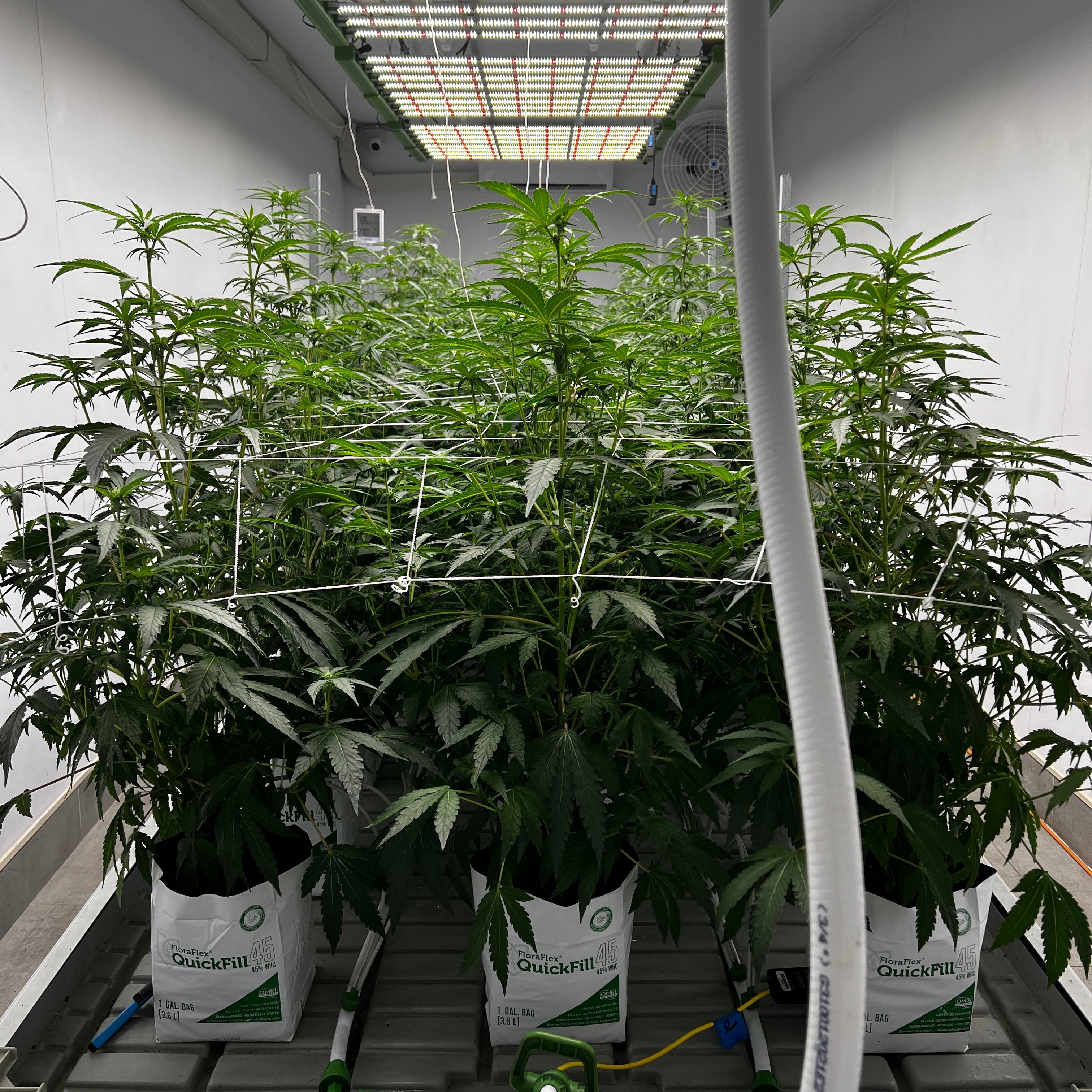To trellis cannabis plants are the most successful way to produce large yields of high-quality flowers. Trellising not only lets you train the plants in the desired direction but also prevents them from growing into each other and forces them to grow outward.
The goal of most marijuana cultivators is to produce as much bud as possible, regardless of whether you are growing a few cannabis plants at home or starting a commercial business. Through the use of the most effective genetics, the careful use of nutrients and watering techniques, and the careful trimming and topping of plants, growers achieve this shared goal. What other incredibly inexpensive method could there be that could improve yields and make plants healthier? A trellising system.
Trellising is an excellent method for ensuring all bud sites receive light creating a more even canopy and providing structure to your plants.
The purpose of this article is to introduce you to the benefits of proper trellising and provide you with an essential guide to implementing this process in your grow room.
Why Should I Trellis Cannabis Plants?
Cannabis plants can benefit from trellising in several ways:
- Branches are given structural support, so heavy buds do not cause the plant to collapse
- The spread-out branches make working on plants easier
- As a result of more branches receiving light, more buds are produced, resulting in greater yields
- Plants are able to breathe more freely, reducing mold and pests
Many cannabis varieties naturally develop tall plants with one large bud at the top and many smaller colas at the end of each branch. In the outdoor growing method, the branches (and buds) receive light throughout the day as the sun moves across the sky.
On the other hand, in an indoor environment or, to a slightly larger capacity, in a greenhouse, this is seldom the case since the lights are stationary, never fully illuminating the sides. Furthermore, it is crucial to maintain as even a canopy as possible when growing indoors due to fading light intensity as the flowers are moved further away from the light source.
Sun-grown cannabis has no such issue as the sun is so far away that a few more feet do not make a significant difference. In the case of indoor cultivation, however, trellising is the most effective means of ensuring that all bud sites receive sufficient light.
A trellis system also provides structure to allow the stalks of plants to grow sideways rather than vertically, creating an even canopy. During trellising, the main goal is to reproduce the consistent footprint of the sunlight outdoors by bringing the top nodes of the branches near the same distance from the source of light. Some growers have seen significant yield increases to trellis cannabis plants using this method.
How to begin trellising cannabis plants
The Flower Stage is where you do trellis: it is difficult to move once a plant is trellised. You can begin the process of trellising your plants in the Veg state by pruning them and shaping them so they will grow out freely on a screen. You can effectively trellis your cannabis plants following the steps below once the plants have moved into Flower.
Installing Trellising In Flower
To install a trellis, you'll want to build the structure above your plants. Growers can create a solid structure to support the plant with plastic netting, nylon string, or other materials. Growers should avoid thin wire or string (for instance, fishing line) because they may cut into the plant tissues. It is intended to create a grid of holes through which the branches and buds will be woven in the next step. You should generally have one to two kola's per 6" x 6" hole in the grid. Ensure that trellis nets are pulled tight. The 3.5" grid is great for the first trellis net layer taking the tuck approach. Another major attribute of maximum efficiency, every 6" square should have plant growth to boost potential yield by getting the most from your light source.
Weaving Branches
A long and lean branch will be easier to bend onto a trellis if it has been grown to be that way. You should be able to bend the branches when you pinch them. There is no need to worry; this will not harm the plant. However, even though the branch can heal itself, be careful not to break it. By bending the branches, it will be possible to weave them in any manner you desire. You should bend and weave the plant down into the trellis netting as it grows upward toward the light so that leaves will fill any gaps.
Positioning Branches
Each hole of the trellis netting should have a single bud site. As a result of the trellis, a grid will be formed with holes typically 3.5"x3.5" or 6" x 6". The plant canopy will develop over the top of the frame after the plant has been bent onto the trellis. Ensure that any additional buds that appear at these developing bud sites are removed.
You want to ensure that each of these holes is occupied by only one bud. When excess buds are removed, the remaining ones will have an easier time growing.
How To Build A Side-Trellis
You can use the same technique for creating vertical side trellising for maximum use of space and yield opportunity, should space provide. Be sure to incorporate vertical lighting to illuminate the buds on the side of the plant when constructing a side canopy.
Trellising Outdoors
A tomato cage or some other premade structure can be used to support young cannabis plants when they are growing outdoors, but tomato cages work well for supporting mature cannabis plants as well. Branches can be pulled through different parts of the cage to help the plant grow into it.
You can also use plant tape and wooden stakes for trellising outdoors. A stake should be inserted in the ground, the branch of a cannabis plant should be extended, and it should be secured to the stake using plant tape. A tomato cage can also be used in conjunction with this method.
It may be easier to build a support frame for all your cannabis plants or to set posts around all of them, depending on their size or how many you have. Outdoors, place large wooden stakes or T-posts into the ground to create a rectangular shape around the plants, and then attach trellising to the posts so that branches are supported.
Be sure to tighten the lines so that the branches do not hang. It may become necessary to add a second trellis line if branches become too heavy over time.
Other Ways to Increase Bud Yield
Trellising is one excellent way to improve bud yield. It reduces the competition for sunlight and nutrients, and it encourages more vertical growth, which tends to produce better buds. But, it's not the only way to increase yield.
Plants grown in soil tend to grow more slowly than those grown in coco or hydroponics, since their roots are challenged with extracting nutrients from the soil (as opposed to obtaining nutrients from the water). The fastest-growing plants will give you the most harvests each year. You'll have more buds if your plants are growing fast!
Your plants may not be producing to their full potential if their nutrients aren't adequate. Make sure your plants' nutrients correspond to their current stage and the medium they are growing in. Plants need high levels of nitrogen, potassium, and phosphorus during vegetation. At flowering, potassium, phosphorus, and nitrogen are all important. Floraflex Nutrients are known for helping growers achieve those dense, large nug goals conceived at the beginning of the growing journey.
Choosing high-quality, high-intensity Full Spectrum LED lights is the best way to increase indoor production. By mimicking the sun's light, you can improve both the quality and quantity of your harvest.
Essentially, your yields are out of your control in some respects. A chance to maximize production can be taken, but the strain itself can limit efforts. Despite trying everything, it is possible you may not be the cause of a low yield. it could be the genetics of the particular strain of cannabis you’re cultivating. It is always worth exploring new options, so take the time to try a different, high-yield strain and observe how it works in your grow operation.
Should I Use a Trellis For Cannabis?
Cannabis plants can be trellised in such a way as to produce a large amount of product. Utilizing as much light as possible and ensuring that all buds in the canopy are on equal levels will result in large, uniformly sized buds throughout the plant. A plant can produce to its maximum capacity by maximizing its resources.















